Evaluation of Urban Resilience of China’s Three Major Urban Agglomerations Using Complex Adaptive System Theory
Abstract
:1. Introduction
2. Study Regions and Data
2.1. Study Regions
2.2. Data
3. Methods
3.1. Complex Adaptive Systems Theory for Urban Resilience Evaluation
3.2. Urban Resilience Assessment Index
3.3. Spatial Autocorrelation Analysis
4. Results
4.1. Resilience Assessment
4.2. Resilience Enhancement Strategy
5. Discussion
6. Conclusions
- (1)
- The average urban resilience value of the three major urban agglomerations in China was 0.5061. Among them, BTH had the highest resilience level at 0.5331, followed by YRD at 0.5116, and GHMB at 0.4612. The results indicate significant regional variations in urban resilience across different cities. To address the deficiencies in some cities within an agglomeration, urban planning should consider specific disaster situations, allocate resources effectively, and enhance disaster prevention awareness among the population;
- (2)
- The resilience levels of cities within the BTH urban agglomeration vary among the northern, central, and southern regions. The cities in the northern part, benefiting from Hebei province’s role as an “ecological environment support area”, exhibit a higher level of resilience. However, the densely populated and economically developed cities in the agglomeration face greater vulnerability;
- (3)
- In the YRD urban agglomeration, the resilience levels of cities in the northwest surpass those in the southeast. The southeast cities, with their abundance of rivers and lakes, are more susceptible to the impact of natural disasters, thereby exhibiting a lower learnability;
- (4)
- The cities in the east and west of the GHMB urban agglomeration demonstrate higher levels of resilience. Augmenting regional resilience presents a unique chance to forge a harmonious mechanism encompassing administrative boundaries. Legislative endeavors can shape resilient urban planning and optimize resource allocation, ultimately culminating in a holistic transformation of urban agglomerations.
Supplementary Materials
Author Contributions
Funding
Institutional Review Board Statement
Informed Consent Statement
Data Availability Statement
Acknowledgments
Conflicts of Interest
References
- McCarthy, M.P.; Best, M.J.; Betts, R.A. Climate change in cities due to global warming and urban effects. Geophys. Res. Lett. 2010, 37. [Google Scholar] [CrossRef]
- Wang, G.; Zhang, Q.; Yu, H.Q.; Shen, Z.X.; Sun, P. Double increase in precipitation extremes across China in a 1.5 °C/2.0 °C warmer climate. Sci. Total. Environ. 2020, 746, 140807. [Google Scholar] [CrossRef]
- Wang, G.; Zhang, Q.; Luo, M.; Singh, V.P.; Xu, C.-Y. Fractional contribution of global warming and regional urbanization to intensifying regional heatwaves across Eurasia. Clim. Dyn. 2022, 59, 1521–1537. [Google Scholar] [CrossRef]
- Xue, Q.R.; Yang, X.H.; Wu, F.F. A three-stage hybrid model for the regional assessment, spatial pattern analysis and source apportionment of the land resources comprehensive supporting capacity in the Yangtze River Delta urban agglomeration. Sci. Total. Environ. 2020, 711, 134428. [Google Scholar] [CrossRef] [PubMed]
- Jabareen, Y. Planning the resilient city: Concepts and strategies for coping with climate change and environmental risk. Cities 2013, 31, 220–229. [Google Scholar] [CrossRef]
- Birhanu, Z.; Ambelu, A.; Berhanu, N.; Tesfaye, A.; Woldemichael, K. Understanding Resilience Dimensions and Adaptive Strategies to the Impact of Recurrent Droughts in Borana Zone, Oromia Region, Ethiopia: A Grounded Theory Approach. Int. J. Environ. Res. Public Health 2017, 14, 118. [Google Scholar] [CrossRef] [PubMed]
- Lu, H.; Lu, X.; Jiao, L.; Zhang, Y. Evaluating urban agglomeration resilience to disaster in the Yangtze Delta city group in China. Sustain. Cities Soc. 2021, 76, 103464. [Google Scholar] [CrossRef]
- Huang, G.Y.; Li, D.Z.; Zhu, X.W.; Zhu, J. Influencing factors and their influencing mechanisms on urban resilience in China. Sustain. Cities Soc. 2021, 74, 103210. [Google Scholar] [CrossRef]
- Zhou, H.; Wang, J.A.; Wan, J.; Jia, H. Resilience to natural hazards: A geographic perspective. Nat. Hazards 2009, 53, 21–41. [Google Scholar] [CrossRef]
- Holling, C.S. Resilience and stability of ecological systems. Annu. Rev. Ecol. Syst. 1973, 4, 1–23. [Google Scholar] [CrossRef]
- Lu, P.; Stead, D. Understanding the notion of resilience in spatial planning: A case study of Rotterdam, The Netherlands. Cities 2013, 35, 200–212. [Google Scholar] [CrossRef]
- Alberti, M.; Marzluff, J.M.; Shulenberger, E.; Bradley, G.; Ryan, C.; Zumbrunnen, C. Integrating humans into ecology: Opportunities and challenges for studying urban ecosystems. BioScience 2003, 53, 1169–1179. [Google Scholar] [CrossRef]
- Godschalk, D.R. Urban Hazard Mitigation: Creating Resilient Cities. Nat. Hazards Rev. 2003, 4, 136–143. [Google Scholar] [CrossRef]
- Pickett, S.T.A.; Cadenasso, M.L.; Grove, J.M. Resilient cities: Meaning, models, and metaphor for integrating the ecological, socio-economic, and planning realms. Landsc. Urban Plan. 2004, 69, 369–384. [Google Scholar] [CrossRef]
- Wardekker, J.A.; de Jong, A.; Knoop, J.M.; van der Sluijs, J.P. Operationalising a resilience approach to adapting an urban delta to uncertain climate changes. Technol. Forecast. Soc. Change 2010, 77, 987–998. [Google Scholar] [CrossRef]
- Meerow, S.; Newell, J.P.; Stults, M. Defining urban resilience: A review. Landsc. Urban Plan. 2016, 147, 38–49. [Google Scholar] [CrossRef]
- Kim, D.; Lim, U. Urban Resilience in Climate Change Adaptation: A Conceptual Framework. Sustainability 2016, 8, 405. [Google Scholar] [CrossRef]
- Ribeiro, P.J.G.; Goncalves, L. Urban resilience: A conceptual framework. Sustain. Cities Soc. 2019, 50, 101625. [Google Scholar] [CrossRef]
- Zheng, Y.; Xie, X.-L.; Lin, C.-Z.; Wang, M.; He, X.-J. Development as adaptation: Framing and measuring urban resilience in Beijing. Adv. Clim. Chang. Res. 2018, 9, 234–242. [Google Scholar] [CrossRef]
- Dong, X.J.; Shi, T.; Zhang, W.; Zhou, Q. Temporal and Spatial Differences in the Resilience of Smart Cities and Their Influencing Factors: Evidence from Non-Provincial Cities in China. Sustainability 2020, 12, 1321. [Google Scholar] [CrossRef]
- Wang, H.; Liu, Z.; Zhou, Y. Assessing urban resilience in China from the perspective of socioeconomic and ecological sustainability. Environ. Impact Assess. Rev. 2023, 102, 107163. [Google Scholar] [CrossRef]
- Shi, Y.; Zhai, G.; Xu, L.; Zhou, S.; Lu, Y.; Liu, H.; Huang, W. Assessment methods of urban system resilience: From the perspective of complex adaptive system theory. Cities 2021, 112, 103141. [Google Scholar] [CrossRef]
- Fang, C.L.; Yu, D.L. Urban agglomeration: An evolving concept of an emerging phenomenon. Landsc. Urban Plan. 2017, 162, 126–136. [Google Scholar] [CrossRef]
- Huang, J.; Sun, Z.; Du, M. Differences and Drivers of Urban Resilience in Eight Major Urban Agglomerations: Evidence from China. Land 2022, 11, 1470. [Google Scholar] [CrossRef]
- Levin, S.; Xepapadeas, T.; Crépin, A.-S.; Norberg, J.; de Zeeuw, A.; Folke, C.; Hughes, T.; Arrow, K.; Barrett, S.; Daily, G.; et al. Social-ecological systems as complex adaptive systems: Modeling and policy implications. Environ. Dev. Econ. 2012, 18, 111–132. [Google Scholar] [CrossRef]
- Grimm, V.; Revilla, E.; Berger, U.; Jeltsch, F.; Mooij, W.M.; Railsback, S.F.; Thulke, H.H.; Weiner, J.; Wiegand, T.; DeAngelis, D.L. Pattern-oriented modeling of agent-based complex systems: Lessons from ecology. Science 2005, 310, 987–991. [Google Scholar] [CrossRef]
- Wu, J. Urban ecology and sustainability: The state-of-the-science and future directions. Landsc. Urban Plan. 2014, 125, 209–221. [Google Scholar] [CrossRef]
- Li, H.B.; Jin, X.B.; Liu, J.; Feng, D.Y.; Xu, W.Y.; Zhou, Y.K. Analytical framework for integrating resources, morphology, and function of rural system resilience-An empirical study of 386 villages. J. Clean. Prod. 2022, 365, 132738. [Google Scholar] [CrossRef]
- Shi, Y.; Zhai, G.; Zhou, S.; Lu, Y.; Chen, W.; Deng, J. How Can Cities Respond to Flood Disaster Risks under Multi-Scenario Simulation? A Case Study of Xiamen, China. Int. J. Environ. Res. Public Health 2019, 16, 618. [Google Scholar] [CrossRef] [PubMed]
- Zhang, Q.; Wu, Z.X.; Yu, H.Q.; Zhu, X.D.; Shen, Z.X. Variable Urbanization Warming Effects across Metropolitans of China and Relevant Driving Factors. Remote Sens. 2020, 12, 1500. [Google Scholar] [CrossRef]
- Shao, Y.; Wu, J.; Ye, J.; Liu, Y. Frequency analysis and its spatiotemporal characteristics of precipitation extreme events in China during 1951–2010. Theor. Appl. Climatol. 2015, 121, 775–787. [Google Scholar] [CrossRef]
- Wang, S.; Song, Y.; Feng, Z.; Jiang, L. Pattern and Progress of Large Urban Agglomerations and Urban Flows Intensity in Northeast China. Sci. Geogr. Sin. 2011, 31, 287–294. [Google Scholar]
- Qiu, B. Methods and Principles of Designing Resilient City Based on Complex Adaptive System Theory. Urban Stud. 2018, 25, 1–3. [Google Scholar]
- Jia, Y.G.; Zhang, B.; Zhang, Y.Z.; Tang, M.; Ma, B.; Wang, G.; Liu, X.; Luo, Z. Effect of Urbanization on Spatial and Temporal Variation of Extreme Temperature Events in the Yangtze River Delta. J. Nat. Resour. 2017, 32, 814–828. [Google Scholar]
- Xu, Q.; Dong, Y.-X.; Yang, R. Urbanization impact on carbon emissions in the Pearl River Delta region: Kuznets curve relationships. J. Clean. Prod. 2018, 180, 514–523. [Google Scholar] [CrossRef]
- Schlüter, M.; Haider, L.J.; Lade, S.J.; Lindkvist, E.; Martin, R.; Orach, K.; Wijermans, N.; Folke, C. Capturing emergent phenomena in social-ecological systems: An analytical framework. Ecol. Soc. 2019, 24, 1–26. [Google Scholar] [CrossRef]
- Andrew, A.M. Systems: An Introductory Analysis with Applications to Biology, Control, and Artificial Intelligence, by John H. Holland MIT Press (Bradford Books), Cambridge, Mass., 1992, xiv + 211 pp. (Paperback £13.50, cloth £26.95). Robotica 1993, 11, 489. [Google Scholar] [CrossRef]
- Braverman, M.; Moitra, A. An information complexity approach to extended formulations. In Proceedings of the ACM Symposium on Theory of Computing, Palo Alto, CA, USA, 1–4 June 2013; p. 161. [Google Scholar]
- Fisher, W.P. Invariance and traceability for measures of human, social, and natural capital: Theory and application. Measurement 2009, 42, 1278–1287. [Google Scholar] [CrossRef]
- Yi, P.T.; Wang, S.N.; Li, W.W.; Dong, Q.K. Urban resilience assessment based on “window” data: The case of three major urban agglomerations in China. Int. J. Disaster Risk Reduct. 2023, 85, 103528. [Google Scholar] [CrossRef]
- Cano, S.J.; Vosk, T.; Pendrill, L.R.; Stenner, A.J. On Trial: The Compatibility of Measurement in the Physical and Social Sciences. J. Physics Conf. Ser. 2016, 772, 012025. [Google Scholar] [CrossRef]
- Tong, P. Characteristics, dimensions and methods of current assessment for urban resilience to climate-related disasters: A systematic review of the literature. Int. J. Disaster Risk Reduct. 2021, 60, 102276. [Google Scholar] [CrossRef]
- Cano, S.J.; Pendrill, L.R.; Melin, J.; Fisher, W.P. Towards consensus measurement standards for patient-centered outcomes. Measurement 2019, 141, 62–69. [Google Scholar] [CrossRef]
- Chandler, H.W. A finite-element implementation of a mixed extremum principle for linear elasticity. Commun. Appl. Numer. Methods 1992, 8, 9–15. [Google Scholar] [CrossRef]
- Chen, C.K.; Xu, L.L.; Zhao, D.Y.; Xu, T.; Lei, P. A new model for describing the urban resilience considering adaptability, resistance and recovery. Saf. Sci. 2020, 128, 104756. [Google Scholar] [CrossRef]
- Qingliang, Z.H.A.; Shiyuan, X.U.; Jun, W.; Beibei, H.U.; Mingwu, Y.E.; Yaolong, L.I.U. A Review of Risk Assessment of Storm Surge on Coastal Cities. Prog. Geogr. 2007, 26, 32–40. [Google Scholar]
- Zhao, D.; Chen, C.; Yi, L.; Lei, P.; Xu, L. Research on comprehensive assessment model of urban resilience with multi-factor. J. Saf. Sci. Technol. 2022, 18, 54–59. [Google Scholar]
- Xue, Y.; Chen, B.; Huang, C.; Yan, J. Soft Hierarchical Model of Integrated Risk Assessment for Multi-hazards: Taking Earthquake and Flood Disasters in Lijiang, Yunnan as a Case Study. Prog. Geogr. 2012, 31, 353–360. [Google Scholar]
- Zhang, Z.X.; Li, Y. Coupling coordination and spatiotemporal dynamic evolution between urbanization and geological hazards—A case study from China. Sci. Total. Environ. 2020, 728, 138825. [Google Scholar] [CrossRef]
- Tepanosyan, G.; Sahakyan, L.; Zhang, C.; Saghatelyan, A. The application of Local Moran’s I to identify spatial clusters and hot spots of Pb, Mo and Ti in urban soils of Yerevan. Appl. Geochem. 2019, 104, 116–123. [Google Scholar] [CrossRef]
- Deroliya, P.; Ghosh, M.; Mohanty, M.P.; Ghosh, S.; Rao, K.; Karmakar, S. A novel flood risk mapping approach with machine learning considering geomorphic and socio-economic vulnerability dimensions. Sci. Total. Environ. 2022, 851, 158002. [Google Scholar] [CrossRef] [PubMed]
- Shi, C.; Zhu, X.; Wu, H.; Li, Z. Assessment of Urban Ecological Resilience and Its Influencing Factors: A Case Study of the Beijing-Tianjin-Hebei Urban Agglomeration of China. Land 2022, 11, 921. [Google Scholar] [CrossRef]
- Wang, Z.B.; Liang, L.W.; Sun, Z.; Wang, X.M. Spatiotemporal differentiation and the factors influencing urbanization and ecological environment synergistic effects within the Beijing-Tianjin-Hebei urban agglomeration. J. Environ. Manag. 2019, 243, 227–239. [Google Scholar] [CrossRef] [PubMed]
- Wang, H.; Zhang, B.; Liu, Y.; Liu, Y.; Xu, S.; Deng, Y.; Zhao, Y.; Chen, Y.; Hong, S. Multi-dimensional analysis of urban expansion patterns and their driving forces based on the center of gravity-GTWR model: A case study of the Beijing-Tianjin-Hebei urban agglomeration. Acta Geogr. Sin. 2018, 73, 1076–1092. [Google Scholar]
- Chen, M.; Guo, S.; Lu, D. Characteristics and spatial patterns of floating population in the Beijing- Tianjin-Hebei urban agglomeration under the background of new urbanization. Prog. Geogr. 2018, 37, 363–372. [Google Scholar]
- Wang, B.; Han, S.; Ao, Y.B.; Liao, F.W. Evaluation and Factor Analysis for Urban Resilience: A Case Study of Chengdu–Chongqing Urban Agglomeration. Buildings 2022, 12, 962. [Google Scholar] [CrossRef]
- Ge, Y.; Dou, W.; Gu, Z.; Qian, X.; Wang, J.; Xu, W.; Shi, P.; Ming, X.; Zhou, X.; Chen, Y. Assessment of social vulnerability to natural hazards in the Yangtze River Delta, China. Stoch. Environ. Res. Risk Assess. 2013, 27, 1899–1908. [Google Scholar] [CrossRef]
- Wu, C.Y.; Wei, Y.H.D.; Huang, X.J.; Chen, B.W. Economic transition, spatial development and urban land use efficiency in the Yangtze River Delta, China. Habitat Int. 2017, 63, 67–78. [Google Scholar] [CrossRef]
- Yang, G.F.; Ge, Y.; Xue, H.; Yang, W.; Shi, Y.; Peng, C.H.; Du, Y.Y.; Fan, X.; Ren, Y.; Chang, J. Using ecosystem service bundles to detect trade-offs and synergies across urban-rural complexes. Landsc. Urban Plan. 2014, 136, 110–121. [Google Scholar] [CrossRef]
- Ding, R.; Xu, B.; Zhang, H. Can Urban Agglomeration Drive Regional Economic Growth?Empirical Analysis Based on Seven State-level Urban Agglomerations. Econ. Geogr. 2021, 41, 37–45. [Google Scholar]
- Li, H.W.; Xu, E.Q.; Zhang, H.Q. Examining the coupling relationship between urbanization and natural disasters: A case study of the Pearl River Delta, China. Int. J. Disaster Risk Reduct. 2021, 55, 102057. [Google Scholar] [CrossRef]
- Song, J.; Luo, M.; Zhang, Q. Risk Prediction of Future Flood Disaster in the Guangdong—Hong Kong—Macau Greater Bay Area. J. Catastrophol. 2022, 37, 197. [Google Scholar]
- Hui, E.C.M.; Li, X.; Chen, T.T.; Lang, W. Deciphering the spatial structure of China’s megacity region: A new bay area-The Guangdong-Hong Kong-Macao Greater Bay Area in the making. Cities 2020, 105, 102168. [Google Scholar] [CrossRef]
- Wu, H.; Fang, S.; Zhang, C.; Hu, S.; Nan, D.; Yang, Y. Exploring the impact of urban form on urban land use efficiency under low-carbon emission constraints: A case study in China’s Yellow River Basin. J. Environ. Manag. 2022, 311, 114866. [Google Scholar] [CrossRef]
- Meng, C.S.; Tang, Q.; Yang, Z.H.; Cheng, H.Y.; Li, Z.G.; Li, K.L. Collaborative control of air pollution in the Beijing–Tianjin–Hebei region. Environ. Technol. Innov. 2021, 23, 101557. [Google Scholar] [CrossRef]
- Liu, C.F.; Su, J.Y.; Zuo, X.J.; Wang, W. Assessment of regional vulnerability to seismic hazards in the Beijing-Tianjin-Hebei metropolitan area, China. Nat. Hazards 2015, 75, 831–848. [Google Scholar] [CrossRef]
- Qu, C.; Wang, J.; He, M. Research on Resource Allocation Optimization of Synergetic Development in Beijing-Tianjin-Hebei Region. Oper. Res. Manag. Sci. 2021, 30, 36–42. [Google Scholar]
- Yang, Z.S.; Yang, H.; Wang, H. Evaluating urban sustainability under different development pathways: A case study of the Beijing-Tianjin-Hebei region. Sustain. Cities Soc. 2020, 61, 102226. [Google Scholar] [CrossRef]
- Zhu, S.Y.; Li, D.Z.; Huang, G.Y.; Chhipi-Shrestha, G.; Nahiduzzaman, K.M.; Hewage, K.; Sadiq, R. Enhancing urban flood resilience: A holistic framework incorporating historic worst flood to Yangtze River Delta, China. Int. J. Disaster Risk Reduct. 2021, 61, 102355. [Google Scholar] [CrossRef]
- Ye, C.; Zhu, J.; Li, S.; Yang, S.; Chen, M. Assessment and analysis of regional economic collaborative development within an urban agglomeration: Yangtze River Delta as a case study. Habitat Int. 2018, 83, 20–29. [Google Scholar] [CrossRef]
- Wang, J.; Gong, Q.; Yu, Y.; Yuan, S.; Chen, J.; Huang, G. Evaluation of comprehensive disaster-bearing capacity of urban natural disasters in the Guangdong-Hong Kong-Macao Greater Bay Area. Geogr. Res. 2020, 39, 2189–2199. [Google Scholar]
- Li, L.; Chan, P.W.; Deng, T.; Yang, H.-L.; Luo, H.-Y.; Xia, D.; He, Y.-Q. Review of advances in urban climate study in the Guangdong-Hong Kong-Macau Greater Bay Area, China. Atmospheric Res. 2021, 261, 105759. [Google Scholar] [CrossRef]
- Guo, C.L.; Sim, T.; Ho, H.C. Impact of information seeking, disaster preparedness and typhoon emergency response on perceived community resilience in Hong Kong. Int. J. Disaster Risk Reduct. 2020, 50, 101744. [Google Scholar] [CrossRef]
- Ainuddin, S.; Routray, J.K. Community resilience framework for an earthquake prone area in Baluchistan. Int. J. Disaster Risk Reduct. 2012, 2, 25–36. [Google Scholar] [CrossRef]
- Zhang, X.W.; Song, J.; Peng, J.; Wu, J.S. Landslides-oriented urban disaster resilience assessment—A case study in ShenZhen, China. Sci. Total. Environ. 2019, 661, 95–106. [Google Scholar] [CrossRef] [PubMed]
- Kotzee, I.; Reyers, B. Piloting a social-ecological index for measuring flood resilience: A composite index approach. Ecol. Indic. 2016, 60, 45–53. [Google Scholar] [CrossRef]
- Johnstone, J.F.; Chapin, F.S.; Hollingsworth, T.N.; Mack, M.C.; Romanovsky, V.; Turetsky, M. Fire, climate change, and forest resilience in interior Alaska. Can. J. For. Res. 2010, 40, 1302–1312. [Google Scholar] [CrossRef]
- Zhao, R.D.; Fang, C.L.; Liu, J.; Zhang, L.F. The evaluation and obstacle analysis of urban resilience from the multidimensional perspective in Chinese cities. Sustain. Cities Soc. 2022, 86, 104160. [Google Scholar] [CrossRef]
- Zhou, R.; Yu, Y.; Wu, B.X.; Luo, X.R. Quantitative evaluation of urban resilience in underdeveloped regions: A study of cities along the Sichuan-Tibet Railway in China. Front. Environ. Sci. 2023, 11, 148. [Google Scholar]
- Cao, F.F.; Xu, X.F.; Zhang, C.L.; Kong, W.B. Evaluation of urban flood resilience and its Space-Time Evolution: A case study of Zhejiang Province, China. Ecol. Indic. 2023, 154, 110643. [Google Scholar] [CrossRef]
- Qasim, S.; Qasim, M.; Shrestha, R.P.; Khan, A.N.; Tune, K.; Ashraf, M. Community resilience to flood hazards in Khyber Pukhthunkhwa province of Pakistan. Int. J. Disaster Risk Reduct. 2016, 18, 100–106. [Google Scholar] [CrossRef]
- Wu, P.; Duan, Q.X.; Zhou, L.G.; Wu, Q.; Deveci, M. Spatial-temporal evaluation of urban resilience in the Yangtze River Delta from the perspective of the coupling coordination degree. Environ. Dev. Sustain. 2023, 1–23. [Google Scholar] [CrossRef] [PubMed]
- Liu, X.L.; Li, S.J.; Xu, X.; Luo, J.S. Integrated natural disasters urban resilience evaluation: The case of China. Nat. Hazards 2021, 107, 2105–2122. [Google Scholar] [CrossRef]
- Lin, Y.Z.; Peng, C.; Chen, P.; Zhang, M.J. Conflict or synergy? Analysis of economic-social- infrastructure-ecological resilience and their coupling coordination in the Yangtze River economic Belt, China. Ecol. Indic. 2022, 142, 109194. [Google Scholar] [CrossRef]
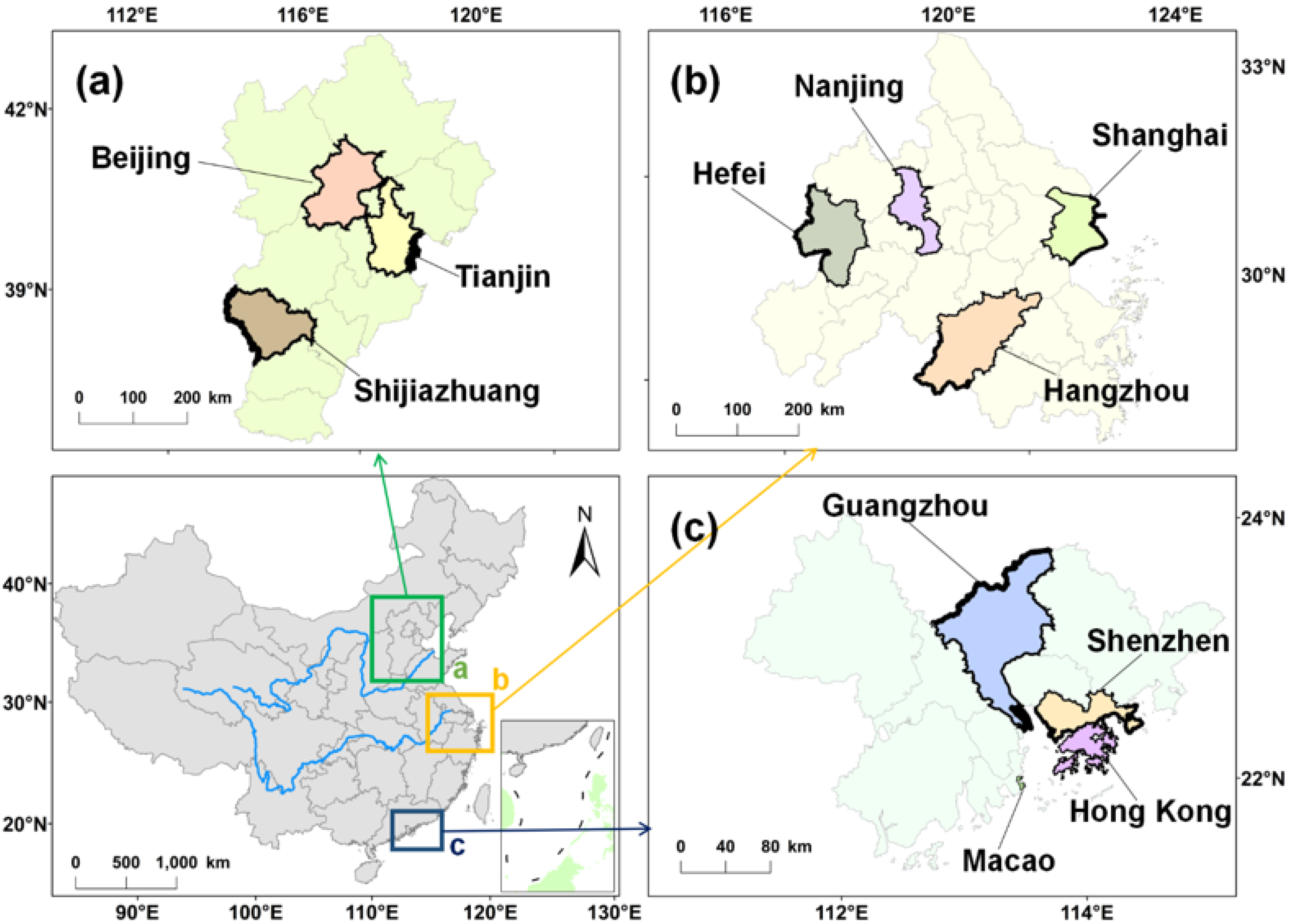
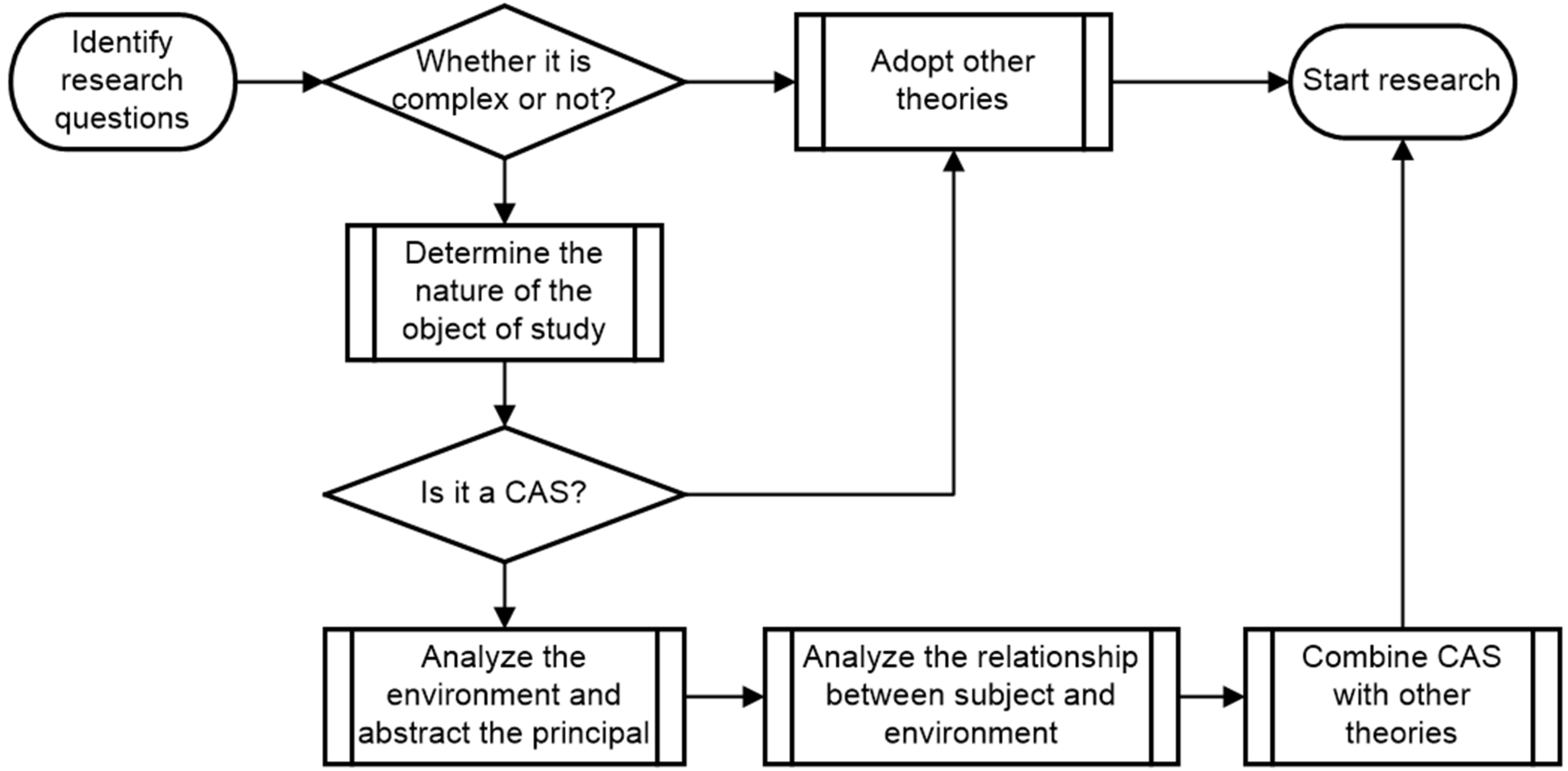
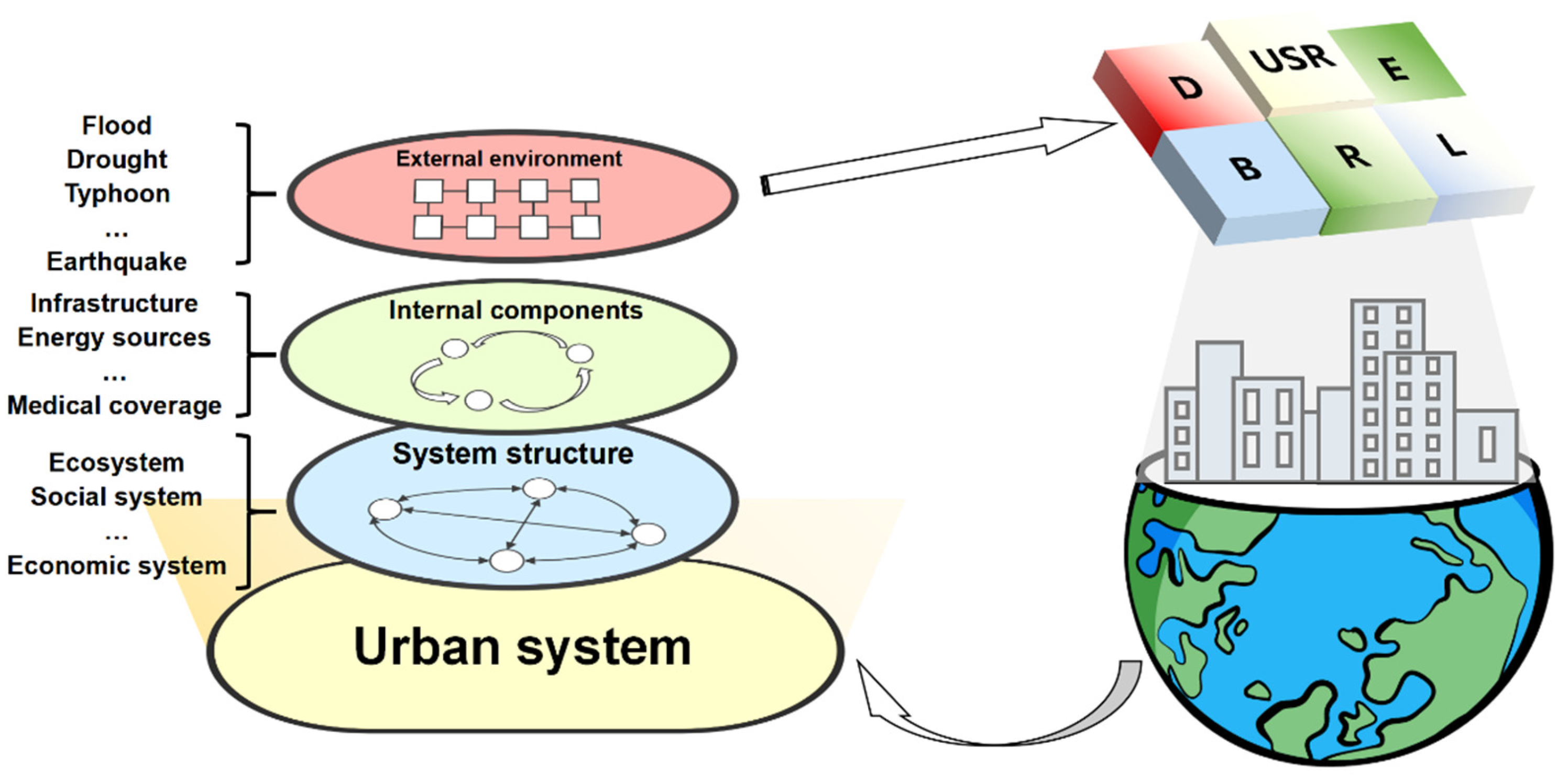

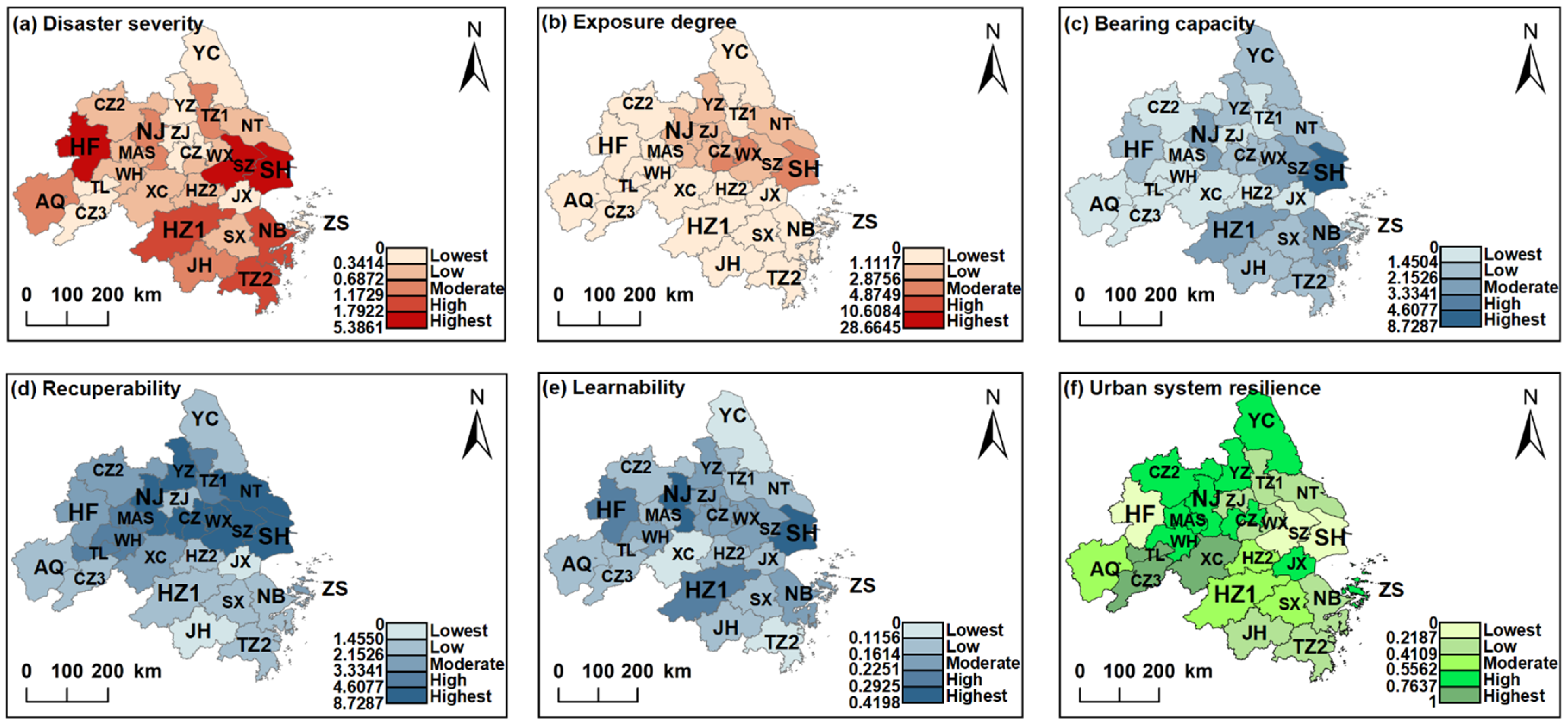
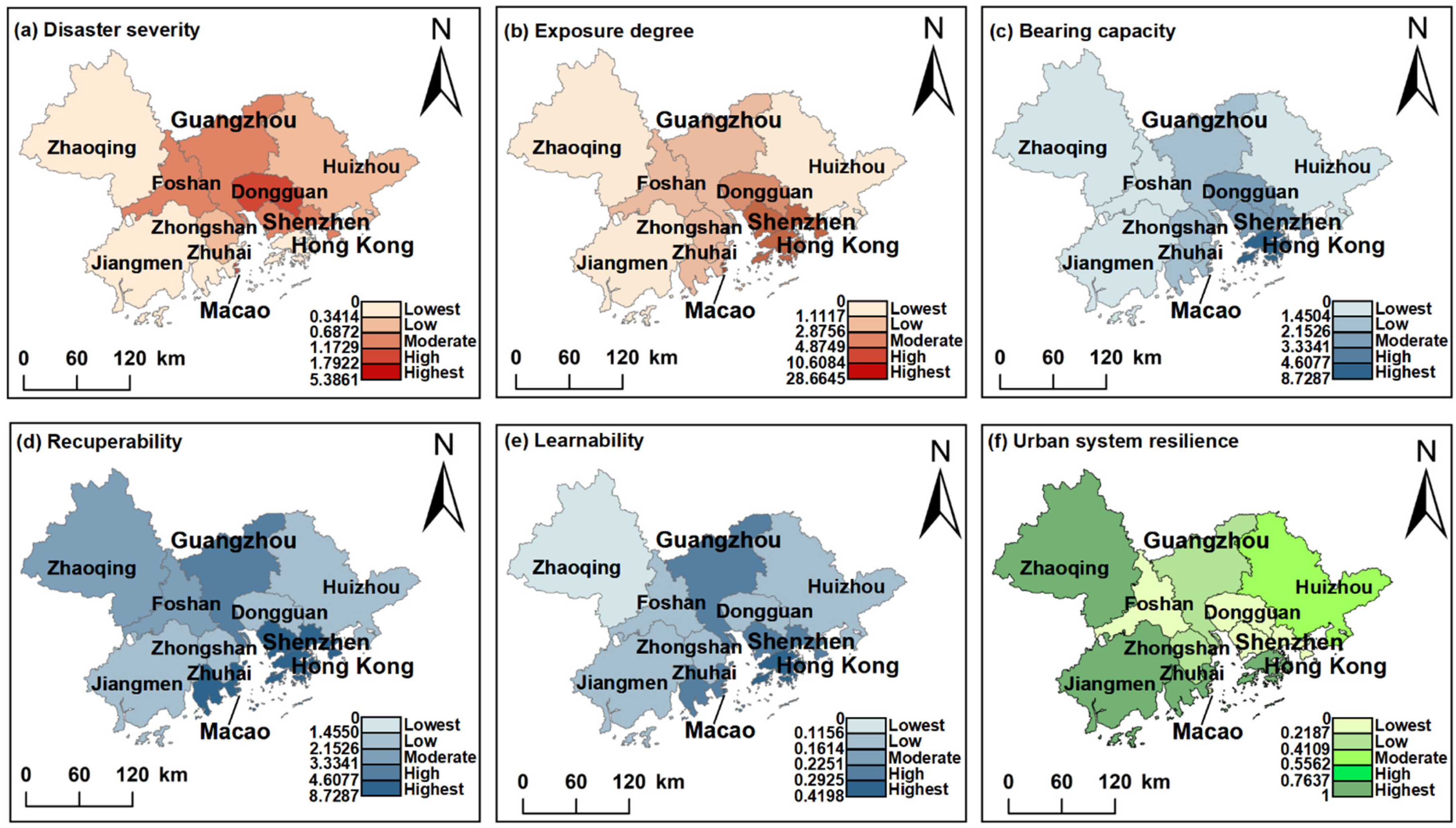
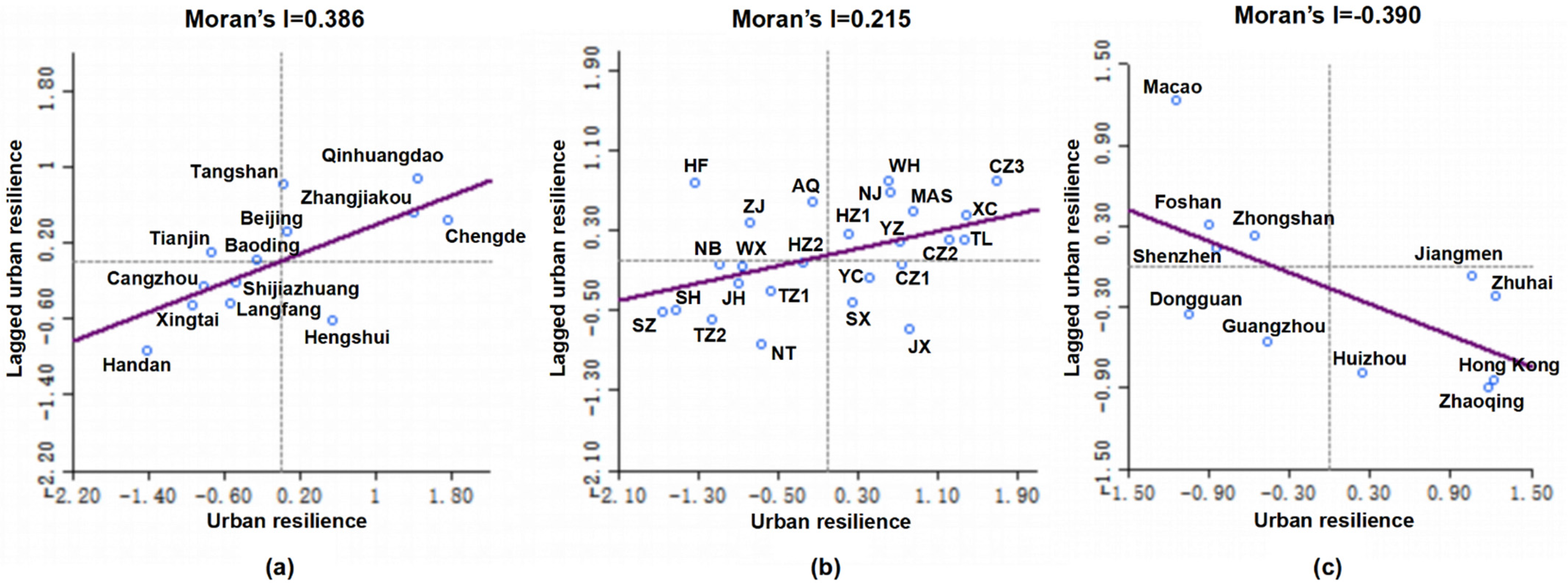
| Variables | Description |
|---|---|
| ED | expenditure on disaster management (CNY) |
| G | regional gross domestic product (CNY) |
| population density (person/km2) | |
| economic density (CNY/km2) | |
| investment proportion of urban public safety (%) | |
| proportion of mobile phone users (%) | |
| proportion of medical insurance in urban population (%) | |
| per capita GDP (CNY/person) | |
| proportion of population with higher education (%) |
Disclaimer/Publisher’s Note: The statements, opinions and data contained in all publications are solely those of the individual author(s) and contributor(s) and not of MDPI and/or the editor(s). MDPI and/or the editor(s) disclaim responsibility for any injury to people or property resulting from any ideas, methods, instructions or products referred to in the content. |
© 2023 by the authors. Licensee MDPI, Basel, Switzerland. This article is an open access article distributed under the terms and conditions of the Creative Commons Attribution (CC BY) license (https://creativecommons.org/licenses/by/4.0/).
Share and Cite
He, C.; Zhang, Q.; Wang, G.; Singh, V.P.; Li, T.; Cui, S. Evaluation of Urban Resilience of China’s Three Major Urban Agglomerations Using Complex Adaptive System Theory. Sustainability 2023, 15, 14537. https://doi.org/10.3390/su151914537
He C, Zhang Q, Wang G, Singh VP, Li T, Cui S. Evaluation of Urban Resilience of China’s Three Major Urban Agglomerations Using Complex Adaptive System Theory. Sustainability. 2023; 15(19):14537. https://doi.org/10.3390/su151914537
Chicago/Turabian StyleHe, Changyuan, Qiang Zhang, Gang Wang, Vijay P. Singh, Tiantian Li, and Shuai Cui. 2023. "Evaluation of Urban Resilience of China’s Three Major Urban Agglomerations Using Complex Adaptive System Theory" Sustainability 15, no. 19: 14537. https://doi.org/10.3390/su151914537
APA StyleHe, C., Zhang, Q., Wang, G., Singh, V. P., Li, T., & Cui, S. (2023). Evaluation of Urban Resilience of China’s Three Major Urban Agglomerations Using Complex Adaptive System Theory. Sustainability, 15(19), 14537. https://doi.org/10.3390/su151914537








